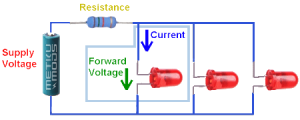Putting them in parallel should also preserve your battery life a bit.
I took electronics engineering in a past life, but probably have forgotten most of what I have learned.
One thing that is ingrained is Ohms Law............... V (Volts)= I (Amps) X R (Resistance)
Now in a parallel circuit, your voltage across each lamp is going to be the same, so basically figure out how many lamps (LEDs) you are going to use, multiply that number by the amount of voltage each LED takes to be lit, and you will end up with the total voltage you will need from your batteries.
You will then place a resistor of the right value in series with the circuit this will give you the proper amperage across the LEDs, too many amps and the LED's burn out. Simple diagram of the basic circuit.
Only thing to add to that circuit would be a switch in the circuit to turn it on and off.
That is the simplest way of doing it. You can get more complicated by introducing some chips and boards to create some cool effects, as well as wiring in capacitors if you wanted a blinking effect to some marker lights....but that gets into the more complicated side of circuitry.



